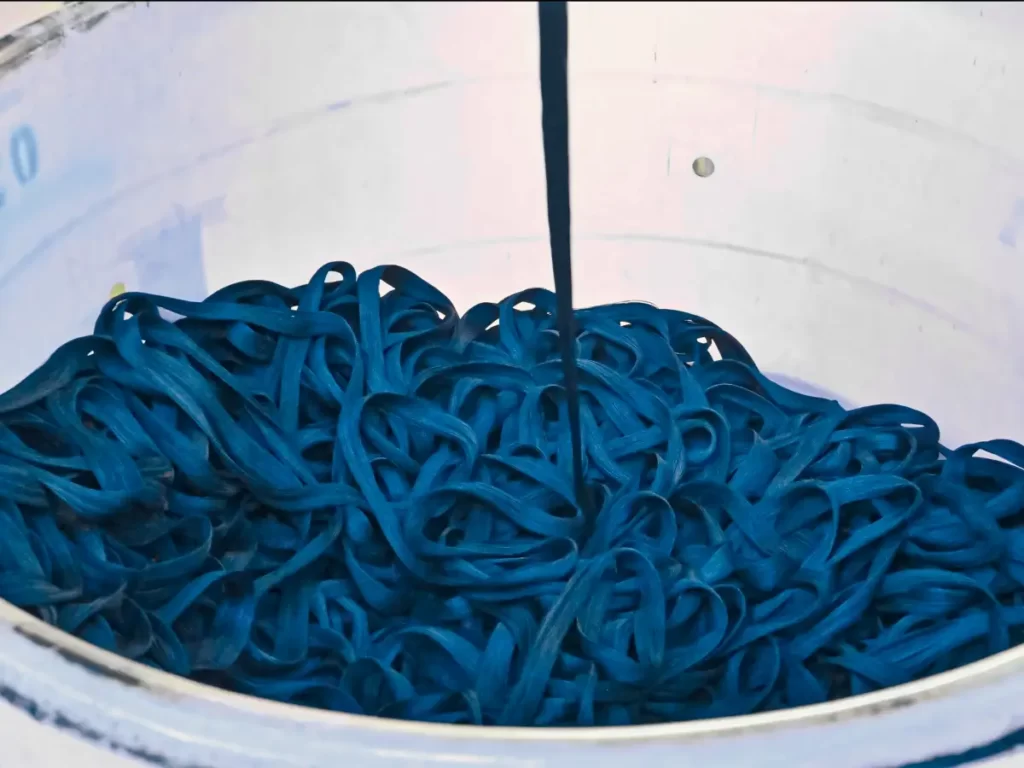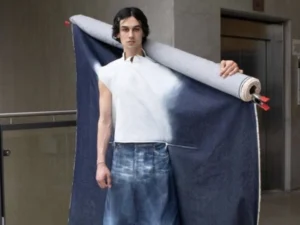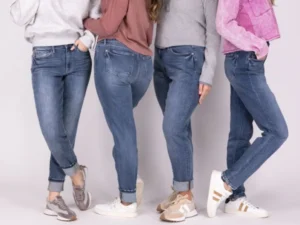Is Denim a Color or Fabric?
There is an argument in the fashion industry that is whether denim should be defined as a fabric or a color. While many consider denim undeniably a fabric due to its unique weave pattern, strong durability, and flexibility to adapt to a variety of garments, others claim that its ubiquitous blue hue should be its defining characteristic, defining it as a color.
Regardless of the debate, denim has universal appeal and continues to be incorporated into many fashion pieces, from classic jeans to modern tank tops and skirts.
- What is denim fabric?
Denim is a beloved and ubiquitous textile, often associated with specific garments, such as jeans, jackets, and workwear. The history of this fabric is rich and multifaceted, with significant industrial and cultural influences. However, the ongoing debate over whether denim is a fabric or a color complicates how it is defined and used. Additionally, the dyeing possibilities of denim are crucial to its appeal and practical use. In this article, we’ll explore the controversy surrounding denim as a color or fabric, why dyed denim is important, and some practical examples of denim use.
Denim is a functional textile mainly made from cotton. Coarse cotton warp yarns are interwoven with finer cotton weft yarns to create a durable, high-density fabric. Fabrics are often finished using specific techniques that give them a unique feel and pattern. Most commonly, denim is associated with blue or indigo dyes, which give it a recognizable look and feel.
- Historical background of denim fabric
In the beginning, denim was used in the 18th century to make sturdy work clothes for European sailors and farmers. The fabric is made in Nîmes, France, from which the name “denim” is derived – “de Nîmes”. later, it became very popular in workwear and casual wear in the United States, because it was more affordable, versatile, and easier to produce, it gained popularity around the world.

- The characteristics of denim fabric
Denim is a cotton twill fabric characterized by twill weaves on the surface of the fabric. The fabric is durable, stiff, and uncomfortable at first, but softens with use and washing. Indigo is the most popular color but it comes in various shades and the color fades over time giving it its unique look. The cotton fibers used to make denim are tightly woven for their strength and durability, while the core yarn makes it incredibly durable.
The process of producing denim is a multi-step, which involves spinning, dyeing, weaving, cutting, and sewing. First, cotton fibers are spun into yarns of the desired thickness and length. The yarn is then dyed using indigo or other dyes. Next, the dyed yarn is woven into the fabric using a twill weave, which gives the denim its signature twill pattern. After weaving, the fabric is cut and sewn into various garments or other products. At last, the finished product usually undergoes finishing treatments such as washing and sandblasting to give it a unique look and feel.
Should Denim be considered a color or a fabric? Some people think that Denim is more like a color because it is usually related to the blue tone from indigo dyes. However, because of its unique characteristics, others believe that denim itself is a kind of fabric. One of the main arguments for taking Denim as a color is that many clothes not made of Denim are still called Denim. For example, a pair of Khaki pants can also be called “denim twill cotton pants” even if it is not denim fabric
On the other hand, there are convincing reasons to regard Denim as a kind of fabric. The denim fabric has unique characteristics that distinguish it from other types of fabrics. For example, Denim is made of tightly woven cotton fiber, which is very durable and wear-resistant. Additionally, the twill fabric used to make denim gives it a unique texture that cannot be replicated by other types of fabrics. These properties make denim an essential fabric in the fashion industry.
Denim also has unique color properties that set it apart from other fabrics. Although Denim usually comes from indigo dyes, it can also be a variety of colors, such as black, gray, or even white. Denim also changes color over time due to wear and tear. This unique characteristic is called “fading” and is often sought after by those who want their denim garments to look well-worn.
In short, the debate about whether Denim is a color or a fabric may continue. However, Denim is a unique fabric and has unique properties and characteristics. From its durability, unique texture, and fading characteristics, Denim will continue to become an important fabric in the fashion industry.
Denim Dyeing
The dyeing process of denim is crucial to its aesthetic appeal and practicality.

Denim dyeing is a complex process that requires skill, knowledge, and practice. It involves various color and fabric considerations such as the quality of the cotton, the choice of dye, concentration, and the method of application. Also, depending on the concentration of the dye, the fabric may vary in color intensity or the look achieved, sometimes adding a unique pattern or nuance to the garment. The ability to dye denim fabric in different shades is critical to keeping it in tune with changing fashion trends, preferences, and styles.
- The Dyeing Process of Denim Fabric
Denim is well known for its unique colors, and the important part of the denim production process is dyeing the fabric. A variety of dyes can be used to achieve desired colors, shades, and designs on denim. there are common dyes way can be used for denim, like natural dyes, mineral-based dyes, synthetic dyes, and sulfur-based dyes. Natural dyes are obtained from plant sources that produce color. They are increasingly popular with environmentalists due to their minimal ecological impact. At the same time, sulfur-based dyes provide deeper colors, making flame-resistant fabrics. Synthetic dyes are the most widely used because of their availability and versatility.
Several dyeing techniques can be used on denim to achieve different effects. The most popular techniques include rope dyeing, sizing dyeing, and reactive dyeing. Rope dyeing involves threading fabric through long ropes of different colors, which are then dipped into a dye bath to achieve unique color effects. Slasher dyeing is a more modern technique in which the fabric is passed through a dyeing machine to inject dye into the core of the yarn. Reactive dyeing is the process of direct reaction between dyes and textile yarns, forming a chemical reaction that is difficult to destroy, resulting in a bright and long-lasting color.
Although the dyeing process looks simple, is a challenge in obtaining the desired color and consistency. A major challenge is ensuring that the dye is applied evenly. If the dye is not evenly distributed, the denim may appear spotty or uneven in color. In addition, the dyeing process will affect the fabric, reducing its durability and strength. therefore, it is important to make sure does not affect the denim quality during the dyeing process.
In short, the dyeing process of denim fabric is indispensable in the production of denim clothing. Challenges associated with dyeing denim include achieving an even distribution of color and ensuring that the dye does not compromise the durability of the fabric. As customer demands continue to evolve, dyeing processes need to be adapted to meet these demands, while also maintaining quality and sustainability standards.
Can Denim Fabric Be Dyed a Lighter Color?
Denim is a classic fabric that is still very popular today. While it’s often associated with blue, sometimes people may want a lighter shade. Fortunately, denim can be dyed a lighter color. Many people choose to dye their denim a light color for a unique look or to refresh a worn-out piece. However, the process is challenging and a person needs to be well-informed before embarking on this endeavor.
As with any dyeing project, the first step is to choose a dye that suits your denim fabric and produces the light shade you want. There are different dye ways available, such as fabric dyes, bleaches, and natural dyes. No matter which method you choose, you are requested to follow the instructions for operation strictly. For example, some methods require stovetop staining, while others require cold water staining. Also, it is advisable to test the dye on a small, inconspicuous area of the garment before expanding to the entire project.
Another important aspect to consider when dyeing denim a lighter color is the type of material. Some denim is made from 100% cotton, while others are mixed with cotton and spandex. Cotton dyes well, but spandex may melt or warp in hot dyeing conditions. During the dyeing process, it is best to observe the denim, ensuring the fabric is not damaged or dyed unevenly. For stubborn stains or stain jobs, it may be necessary to repeat the process until the desired result is achieved.
In conclusion, dyeing denim can be tricky, but with a little care and attention, one can successfully dye denim in lighter shades. Choosing the right dye and following directions carefully is crucial to ensuring an even and permanent dye job. Also, considering the fabric type before dyeing can help prevent damage and distortion. Whether you’re a DIY enthusiast or just looking to revamp your wardrobe, dyeing denim a lighter color is an exciting and fun project that will yield great results.
We have seen that Denim is a strong and classic fabric that can be dyed to create a new and unique appearance. We still recommend providing tips on selecting the correct dye, testing the dye on a small area first, and paying attention to the type of fabric before entering the dyeing process.
Conclusion
In a word, Denim is a multi-functional fabric, which provides various possibilities for creativity and self-expression.
Whether jeans, jackets, or Denim skirts, dyed Denim can add a fresh and personalized touch to any outfit. By understanding the characteristics of fabrics and their dyeing possibilities, we can make informed decisions and achieve the expected results. Dyeing Denim to a lighter color is an interesting and beneficial project, which can inject new vitality into your wardrobe.





